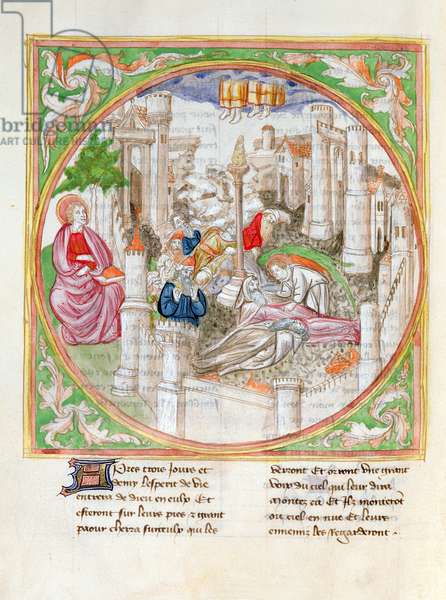
This post concludes Thomas Witulski’s analysis of the text of Revelation 11:3-13.
On the verses describing the resurrection and ascension of the two witnesses, W judges that they are inserted by a later hand for the following reasons.
The narrative of the two witnesses up to the moment of their deaths is told in the present and future tenses but there is an abrupt change in tense in the account of their resurrection and ascension. Up until the deaths of the two witnesses we are reading a prophecy: after their deaths, suddenly we are in the “past tense” and what reads like a vision:
The next segment of the narrative (vv 11–13) centers on the unexpected event of the resurrection and ascension of the two witnesses as well as the punishment of their enemies. Somewhat surprisingly, this section is dominated by verbs in the past tense, as if it were a narrative of a past sequence of events.
(Aune, 587)
This abrupt change of tense comes with a change of genre, a change to a visionary report:
in vv. 11-13 he changes to the [aorist], as narrating what he had already seen and heard in vision.
(Beckwith, 603)
The imagery of the spirit of God entering them so that they come to life and stand on their feet comes from Ezekiel 37:10, another visionary account.
W discusses various attempts to explain this change of tense: it cannot be a simple Hebraism because the question relates to change of tense, not merely using a past tense to stress the certainty of future events; other proposals fail to explain why a single author would have failed to have reworked his source material to be more consistent with the tense here as he is when reworking material from Zechariah.
His own view, translated, is as follows.
Within the framework of literary criticism, the verses Rev 11:11-13 are to be regarded as not having been written by the apocalyptist, but as having been secondarily inserted into the already existing context by a later hand, without this interpolator having taken into account that Rev 11:3-10 are formulated as a prophecy and not as a visionary report; the insertion was then possibly made in order to align the account of Rev 11 with that tradition which describes the appearance of Elijah and Enoch, offering both their death and their subsequent resurrection, or else in order to present the orientation of the message through the two μάρτυρες as an ultimately successful engagement. Whether the interpolator, who would then have added Rev 11:11-13, would still have been aware of the original reference of the depiction Rev 11:3-10 and its original historical-temporal background, would, however, have to remain extremely questionable.
(translated from Witulski, 128f)
The interpolator was not aware of the original account’s reference to certain historical persons. Such a conclusion begins to make sense of the questions raised in the previous post:
It is also odd that we read nothing further here about the beast from the abyss that had just killed the two “witnesses” or “martyrs”. It is as if he is no longer at the scene to witness the sudden turn of events and the ascension to heaven.
One more oddity: only in this passage in Revelation do enemies of God give glory to God as a result of witnessing or experiencing calamitous events like an earthquake or plague or other catastrophe. In every other such scenario they respond with intensified anger.
The significance of that last point is emphasized again in further discussion below — see text f.
After this analysis of what, exactly, the passage is saying and what appears to be its provenance, W is in a position to demonstrate the historical circumstances that informed details of the account of the two witnesses. But those historical references will have to wait for a future post. At this point we are laying the groundwork for that historical interpretation. Continue reading “The Two Witnesses of Revelation 11 – part D”
